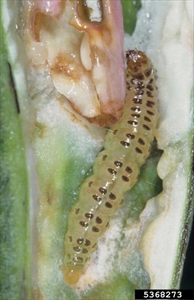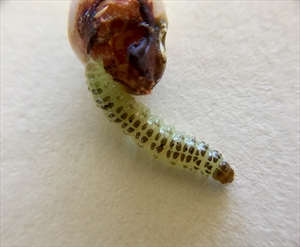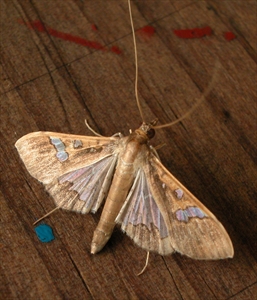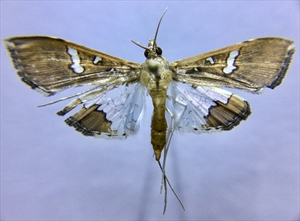- Worldwide distribution. In tropics. On bean, including French bean, cowpeas, pigeon peas and yard long beans. An important pest.
- Caterpillars have two rows of black dots on the back.
- At first, caterpillars feed in the flowers making webs, then bore into the pods to eat the seeds. Look for frass – waste matter – at entry holes.
- Cultural control: avoid planting near old crops; handpick flowers with webbing; grow maize/sorghum between bean rows; collect debris and destroy; check AVRDC for tolerant varieties.
- Chemical control: aim to kill caterpillars in flowers as difficult for chemicals to enter pods. PDPs: neem, derris, pyrethrum, or chilli; use spinosad or Bt (Bacillus thuringiensis). Alternatively, synthetic pyrethroids, but may kill natural enemies.
Pacific Pests, Pathogens and Weeds - Online edition
Pacific Pests, Pathogens, Weeds & Pesticides
Bean pod borer (037)
Bean pod borer
Maruca vitrata; it used to be known as Maruca testulalis.
AUTHORS Grahame Jackson, Mani Mua & Helen Tsatsia
Information from Bean podborer (2018) Business Queensland. Queensland Government. (https://www.business.qld.gov.au/industries/farms-fishing-forestry/agriculture/crop-growing/pests-field-crops/bean-podborer); and CABI (2020) Maruca vitrata (lime bean pod borer). Crop Protection Compendium. (https://www.cabi.org/cpc/datasheet/32566). Photo 1 Shepard M, et al. Insects and their Natural Enemies Associated with Vegetables and Soybean in Southeast Asia, Bugwood.org. Photo 3 Gerald McCormack, Cook Islands Biodiversity Website: (http://cookislands.bishopmuseum.org/).
Produced with support from the Australian Centre for International Agricultural Research under project PC/2010/090: Strengthening integrated crop management research in the Pacific Islands in support of sustainable intensification of high-value crop production, implemented by the University of Queensland and the Secretariat of the Pacific Community.







